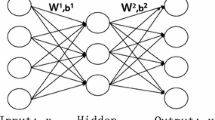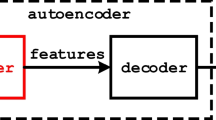Abstract
Hyperspectral remote sensing enables a detailed spectral description of the object’s surface, but it also introduces high redundancy because the narrow contiguous spectral bands are highly correlated. This has two consequences, the Hughes phenomenon and increased processing effort due to the amount of data. In the present study, it is introduced a model that integrates stacked-autoencoders and convolutional neural networks to solve the spectral redundancy problem based on the feature selection approach. Feature selection has a great advantage over feature extraction in that it does not perform any transformation on the original data and avoids the loss of information in such a transformation. The proposed model used a convolutional stacked-autoencoder to learn to represent the input data into an optimized set of high-level features. Once the SAE is learned to represent the optimal features, the decoder part is replaced with regular layers of neurons for reduce redundancy. The advantage of the proposed model is that it allows the automatic selection and extraction of representative features from a dataset preserving the meaningful information of the original bands to improve the thematic classification of hyperspectral images. Several experiments were performed using two hyperspectral data sets (Indian Pines and Salinas) belonging to the AVIRIS (Airborne Visible/Infrared Imaging Spectrometer) sensor to evaluate the performance of the proposed method. The analysis of the results showed precision and effectiveness in the proposed model when compared with other feature selection approaches for dimensionality reduction. This model can therefore be used as an alternative for dimensionality reduction.















Similar content being viewed by others
References
Ahmad M, Protasov S, Khan AM (2017) Hyperspectral band selection using unsupervised non-linear deep auto encoder to train external classifiers. CoRR abs/1705. 06920. URL http://arxiv.org/abs/1705.06920. Accessed 17 Jan 2023
Benediktsson JA, Ghamisi P (2015) Spectral-spatial classification of hyperspectral remote sensing images. Artech House, London
Bengio Y (2012) Deep learning of representations for unsupervised and transfer learning. In Proceedings of ICML workshop on unsupervised and transfer learning (pp. 17–36)
Cheng G, Han J, Lu X (2017) Remote sensing image scene classification: benchmark and state of the art. Proc IEEE 105(10):1865–1883
Donahue J, Jia Y, Vinyals O, Hoffman J, Zhang N, Tzeng E, Darrell T (2014) DeCAF: a deep convolutional activation feature for generic visual recognition. In Proceedings of the international conference on machine learning (pp. 647–655).
Ettabaa KS, Salem MB (2018) Adaptive progressive band selection for dimensionality reduction in hyperspectral images. J Indian Soc Remote Sens 46(2):157–167
Ghamisi P, Plaza J, Chen Y, Li J, Plaza AJ (2017) Advanced spectral classifiers for hyperspectral images: a review. IEEE Geosci Remote Sens Mag 5(1):8–32
Hancer E, Xue B, Zhang M (2020) A survey on feature selection approaches for clustering. Artif Intell Rev 53:4519–4545
Huang X, Wu L, Ye Y (2019) A review on dimensionality reduction techniques. Int J Pattern Recognit Artif Intell 33(10):1950017
Hughes GF (1968) On the mean accuracy of statistical pattern recognizers. IEEE Trans Inform Theory IT 14:55–63
Jia X, Richards JA (1994) Efficient maximum likelihood classification for imaging spectrometer data sets. IEEE Trans Geosci Remote Sens 32(2):274–281
Khan M, Jan B, Farman H (2019) Deep learning: convergence to big data analytics. Springer, Singapore
Landgrebe DA (2005) Signal theory methods in multispectral remote sensing. John Wiley & Sons
LeCun Y, Bengio Y, Hinton G (2015) Deep learning. Nature 521(7553):436
Liu Q, Zhou F, Hang R, Yuan X (2017) Bidirectional-convolutional LSTM based spectral-spatial feature learning for hyperspectral image classification. Remote Sens 9(12):1330
Ma X, Wang H, Wang J (2016) Semisupervised classification for hyperspectral image based on multi-decision labeling and deep feature learning. ISPRS J Photogramm Remote Sens 120:99–107
Ma L, Liu Y, Zhang X, Ye Y, Yin G, Johnson BA (2019) Deep learning in remote sensing applications: a meta-analysis and review. ISPRS J Photogramm Remote Sens 152:166–177
Mei S, Ji J, Geng Y, Zhang Z, Li X, Du Q (2019) Unsupervised spatial–spectral feature learning by 3D convolutional autoencoder for hyperspectral classification. IEEE Trans Geosci Remote Sens 57(9):6808–6820
Nogueira K, Penatti OA, Dos Santos JA (2017) Towards better exploiting convolutional neural networks for remote sensing scene classification. Pattern Recogn 61:539–556
Ramamurthy M, Robinson YH, Vimal S, Suresh A (2020) Auto encoder based dimensionality reduction and classification using convolutional neural networks for hyperspectral images. Microprocess Microsyst 79:103280
Serpico SB, D’Inca M, Melgani F, Moser G (2003) Comparison of feature reduction techniques for classification of hyperspectral remote sensing data. In Proceedings of SPIE. Image and signal processing of remote sensing VIII, 4885, 347–358
Shen Q, Diao R, Su P (2012) Feature selection ensemble. Turing-100 10:289–306
Venkatesh B, Anuradha J (2019) A review of feature selection and its methods. Cybern Inf Technol 19(1):3–26
Wang Y, Yao H, Zhao S (2016) Auto-encoder based dimensionality reduction. Neurocomputing 184:232–242
Xing C, Ma L, Yang X (2016) Stacked denoise autoencoder based feature extraction and classification for hyperspectral images. J Sensors 3632943:3–13
Zabalza J, Ren J, Zheng J, Zhao H, Qing C, Yang Z, Marshall S (2016) Novel segmented stacked autoencoder for effective dimensionality reduction and feature extraction in hyperspectral imaging. Neurocomputing 185:1–10
Zebari R, Abdulazeez A, Zeebaree D, Zebari D, Saeed J (2020) A comprehensive review of dimensionality reduction techniques for feature selection and feature extraction. J Appl Sci Technol Trends 1(2):56–70
Acknowledgements
The authors would like to thank the colleagues of the Postgraduate Course in Geodetic Sciences (Federal University of Paraná, Brazil) for the valuable discussions and debates about the research and for the support provided. The authors would also like to thank to Purdue University, USA, for providing the AVIRIS hyperspectral data.
Author information
Authors and Affiliations
Corresponding author
Ethics declarations
Competing interests
The authors declare no competing interests.
Rights and permissions
Springer Nature or its licensor (e.g. a society or other partner) holds exclusive rights to this article under a publishing agreement with the author(s) or other rightsholder(s); author self-archiving of the accepted manuscript version of this article is solely governed by the terms of such publishing agreement and applicable law.
About this article
Cite this article
Jijón-Palma, M.E., Amisse, C. & Centeno, J.A.S. Hyperspectral dimensionality reduction based on SAE-1DCNN feature selection approach. Appl Geomat 15, 991–1004 (2023). https://doi.org/10.1007/s12518-023-00535-6
Received:
Accepted:
Published:
Issue Date:
DOI: https://doi.org/10.1007/s12518-023-00535-6




